Dipylon, Carlsberg
Arches and vaults in DenmarkClock towers in CopenhagenGates in CopenhagenIndustrial buildings completed in 1892Vesterbro, Copenhagen ... and 1 more
Vilhelm Dahlerup buildings

The Dipylon, or the Double Gate (Danish: Dobbeltporten), is a landmark structure which spans Ny Carlsberg Vej in the Carlsberg area of Copenhagen, Denmark. Part of the now decommissioned Carlsberg Brewery site, it combines a double-arched gateway, from which it takes its name, with a clock tower. The name which simply means "double gate" in Greek, refers to a gateway in the north-west of ancient Athens.
Excerpt from the Wikipedia article Dipylon, Carlsberg (License: CC BY-SA 3.0, Authors, Images).Dipylon, Carlsberg
Geographical coordinates (GPS) Nearby PlacesShow on map
Geographical coordinates (GPS)
| Latitude | Longitude |
|---|---|
| N 55.6672 ° | E 12.5333 ° |











